February 10, 2017
Air Date: February 10, 2017
FULL SHOW
SEGMENTS

A Carbon Dividend Plan
View the page for this story
Conservatives could support a carbon tax if it also reduced EPA regulations and made payments to consumers to offset the costs, say advocates led by Republican elder statesmen, including former Secretary of State James Baker. They have proposed an ambitious Carbon Dividend plan that could entice bipartisan support, pay families $2000 a month, and cut greenhouse gas emissions more than Obama’s Clean Power Plan. Co-author Ted Halstead of the Climate Leadership Council explains its appeal and mechanics to host Steve Curwood. (15:30)
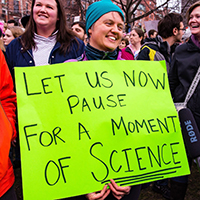
Beyond The Headlines
/ Peter DykstraView the page for this story
In this week’s trip beyond the headlines, Peter Dykstra and host Steve Curwood note that China doubled its solar capacity within 12 months, and discuss scientists’ newfound political activism. Looking back 45 years, they remember the animated film of Dr Seuss’s The Lorax, and the furry creature’s rearguard action to speak for and protect the trees. (04:30)
.jpg)
BirdNote: What's in a Name?
/ Mary McCannView the page for this story
Watching the birds at your feeder is a pleasure for many, but as Mary McCann comments in today’s BirdNote, identifying them can be a headache, as some as reclassified and now have new names. (02:00)

Sex and Sustainability in the Sea
View the page for this story
The extensive ecosystem under the waves depends on the intricate, complex and mysterious mating rituals of its inhabitants. Host Steve Curwood speaks with Marah Hardt, a marine biologist and author of a new book, Sex in the Sea about some clever and unusual reproductive strategies unique to sea-dwellers and why understanding this is critical for maintaining the resource. They then discuss how lobsters communicate their readiness to mate, how some whales try to ensure their genes will persist, and how static corals in reefs manage to make more corals, and Hardt argues that success in their various methods are vital for sustainable fisheries. (25:25)
Show Credits and Funders
Show Transcript
HOST: Steve Curwood
GUESTS: Ted Halstead, Marah Hardt
REPORTERS: Peter Dykstra, Mary McCann
[THEME]
CURWOOD: From Public Radio International, this is Living on Earth.
[THEME]
CURWOOD: I'm Steve Curwood. Republican leaders from the Reagan and first Bush Administrations push a new plan to tax carbon and give that money right back to consumers.
BAKER: There’s a carbon tax buried in there somewhere, but this is a program on carbon dividends. Make sure you understand that. And every American is going to get a dividend quarterly, from the taxes that are collected on the production of carbon.
CURWOOD: A bold new plan to tackle global warming and rollback regulation. Also, for Valentine’s Day we look at how nature’s way of supplying seafood can help educate the public.
HARDT: If you talk about sex, people are curious, and maybe there's a way that you can talk about sex, draw their attention, and then subtly weave in the message of conservation because ultimately, successful sex is the heart of sustainability.
CURWOOD: Sex and more this week, on Living on Earth. Stick around.
[NEWSBREAK MUSIC: Boards Of Canada “Zoetrope” from “In A Beautiful Place Out In The Country” (Warp Records 2000)]
[THEME]
A Carbon Dividend Plan

The carbon tax dividend Halstead and his colleagues are proposing would initially raise the price of a gallon of gas by 36 cents, at a price of $40/ton of carbon dioxide, but rebate it all to consumers. (Photo: Mike Mozart, Flickr CC BY 2.0)
CURWOOD: From PRI and the Jennifer and Ted Stanley Studios at the University of Massachusetts Boston, this is Living on Earth. I’m Steve Curwood. Capitol Hill action on global warming has been stalled for years, but that could change thanks to a plan being advanced by Republican senior statesman, James Baker.
BAKER: There’s a carbon tax buried in there somewhere, but this is a program on carbon dividends. Make sure you understand that. And every American is going to get a dividend quarterly, from the taxes that are collected on the production of carbon.
CURWOOD: The former secretary of both state and treasury is leading the launch of this new plan to reign in carbon emissions. It’s called “The Conservative Case for Carbon Dividends.” The title aims to entice tax-averse GOP legislators to sign on. Ted Halstead, founder and President of the Climate Leadership Council, is a co-author of this daring new blueprint, and HE joins me now. Welcome to Living on Earth.
HALSTEAD: Nice to be with you, Steve.
CURWOOD: So, Ted, why hook up with really senior powerful Republicans for this vision of how to move forward on the climate?
HALSTEAD: Because the main impediment to solving climate change at the necessary scale and speed is one party in one country. The major breakthrough that is needed is getting the Republican party on board for a climate solution that fits the conservative world view, and it's been a profound honor to work with such distinguished figures as George Schultz, Jim Baker, Hank Paulson, Marty Feldstein, and Greg Mankiw. So, we have three former Republican secretaries of treasury, two former Republican secretaries of state, and two former Republican chairs of the Council of Economic Advisers. We also are fortunate to have Rob Walton as a co-author who is the former chairman of Walmart, of course, the world's largest private employer.
CURWOOD: Ted, for years, former South Carolina Congressman Bob Inglis has been calling for a carbon tax. What exactly does your plan call for?

“The Conservative Case for Carbon Dividends” was produced by a collaboration that includes senior Republican leaders. (Photo: Climate Leadership Council)
HALSTEAD: A carbon tax is part of what we are proposing, but our plan is called “carbon dividends,” and it's a very different beast. I mean, simply put, an economist would tell you that a carbon tax is the most efficient way to solve climate change. The problem is that proponents of that position have long lacked a coherent political strategy to move forward on that issue because, by itself, a carbon tax is deeply unpopular. So, what we're proposing is a carbon tax with 100 percent of the proceeds going back to the American people in the form of dividends. Now, that's just one of the arguments in favor of it. For Republicans, the arguments that I think will be equally powerful is that this is a pro-growth plan. This is a pro-competitiveness plan. This is a plan to reduce regulation and shrink the government, all the while saving our climate. So, it's a new synthesis, but it is built on bedrock Republican principles.
CURWOOD: Alright. Now, let's walk through the four basic elements of your plan. At the top of the list, and the title that you use for this, is a dividend from carbon. In other words, a typical family of four would receive about $2,000 a year. So, this dividend means that any tax, if I understand correctly, would be essentially for the economy - neutral. There will be no growth in government. There would be no drag on growth in the conventional economy this way.
HALSTEAD: That's correct. It would be revenue neutral; however, just to clarify, every American would get a dividend, and every American would get the same dividend whether you're rich or you're poor. But what the Treasury Department found in studying this is that for the bottom 70 percent of Americans, they would come out ahead, meaning they would receive more in dividends than the added cost for carbon. That means 223 million Americans stand to benefit from this new solution to climate change. So, it's a real populist climate solution that fits our political moment.
CURWOOD: How is the public going to embrace this when the first thing they're going to see is the higher price of gasoline, more money at the pump?
HALSTEAD: Well, first of all, we’ll probably make the dividend monthly, so people would get it monthly, and we may even try to pay it in advance the first month so that there is none of that problem. In order words, the dividend comes first, and increased payments come second. But again, the key point: The bottom 20 percent of Americans, 223 million Americans, would come out ahead.
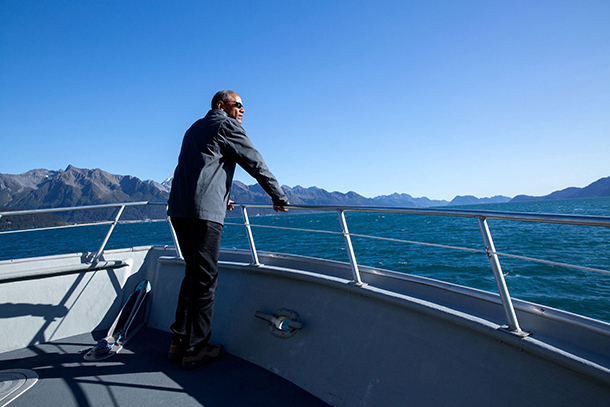
Ted Halstead says the carbon dividends plan would cut twice as many greenhouse gas emissions as former President Obama’s Clean Power Plan. Above, Obama stands at the bow of a ship on a 2015 tour of Alaska that highlighted the impacts of climate change. (Photo: Pete Souza / White House, public domain)
CURWOOD: So, let's talk about the tax. You say it would begin at the level at $40 for each ton of carbon dioxide associated with the emissions, and then it would ratchet up. How high could it go?
HALSTEAD: Well, you know, $40 per ton is near the high end of what is politically feasible in Washington today. That's about $.36 cents per gallon extra at the pump. When you ask of what is ultimately needed, it's a much higher number, if you work backwards from the goal of keeping climate change or warming, rather, at the limit of 2 degrees Centigrade that all scientists and all world leaders who attended the Paris conference recently agreed to. So, if that's the goal, we need to reduce CO2 emissions in America by about 70 percent by mid-century, and in order to accomplish that, you need a tax that's at $100 per ton or more. But that's not the starting point. You need to get people comfortable with this. In our paper, we said after five years, a Blue Ribbon commission should analyze whether to continue growing, based on the latest climate data. So, there is a built-in checkpoint after five years.
CURWOOD: Now, your third pillar of this, you call border carbon adjustments, that is, that people say manufacturing goods or producing something in another country that doesn't have carbon constraints might be able to, in the words of an economist, dump their carbon heavy products in the US and undercut local production which is subject to the tax. But what about the other way around? What disincentives are there for American companies to go and get carbon intensive fuels such as coal and export it, where it'll get burned in countries that it may not have any regulation of carbon?
HALSTEAD: So, if companies are doing that now there would be no change in incentives for them. What we're trying to do is improve on what we have now, and what is not widely understood is that the current global economic rules of the game actually subsidize dirty producers abroad. So, you know, President Trump is particularly concerned about the way in which our environmental regulations could hurt American companies and jobs and so forth. Well, the best answer to trading with partners that have weaker environmental standards is not to lower our standards. It's to penalize them for theirs, and that is exactly what our border carbon adjustment would do. So, if we're trading with a company that has lower carbon prices than the ones that we put in place, we would tax them at the border for the difference. By contrast, because we, of course, don't want to harm our own companies, if our country's export to a nation that has lower environmental cost, they would get a rebate for any carbon tax that they've paid.

British Columbia’s carbon emissions have gone down since a carbon tax was implemented there in 2008, as compared to the rest of Canada. (Photo: Lawrencekhoo,Wikimedia Commons CC0 1.0)
CURWOOD: But what are the disincentives for American companies to go, say, mine coal out of the Powder River Basin and export it to the world. Any carbon dioxide molecule anywhere in the world is contributing to global warming whether it's emitted in the US or in China or India or, you know, some Third World country that has virtually no limits on carbon emissions.
HALSTEAD: So, Steve, that's an insightful question, and you are correct that our system would not provide a disincentive for that. But, I would point out that that would be no change from where we are today. What would change, though, is that, by putting in place a system of border carbon adjustments, it would very soon compel other countries to set up their own carbon pricing at similar levels to ours, and then -- Guess what -- any coal mined in the United States and exported would be subject to the exact same taxes, and of the various fossil fuels everybody knows that coal is the most carbon intensive. So, coal will be hit very hard by our plan, but even there there's an elegant way out. It turns out that at a carbon price of between $50 to $100 per ton, it becomes economical for utilities to invest in carbon capture technologies at the coal plants. So, what we end up with is not the end of the coal industry as some fear, but rather, clean coal.
CURWOOD: The fourth major pillar of your proposal is to roll back lots of regulations and course, in particular, there's the question of President Obama's Clean Power Plan. Tell me how your carbon tax and dividend proposal compares to the Clean Power Plan, in terms of carbon emissions averted and rules that you think could be removed.
HALSTEAD: Sure, when we put out our statement, we put out a corresponding analysis by two of the top scholars in the field and what it found is quite stunning. It compared our plan to all Obama-era climate regulations, including a full implementation of the Clean Power Plan, and what the study found is that our plan would achieve nearly twice the emission reductions of all the Obama-era policies combined. What's more, the study also found that with our plan and our plan alone, America could meet the high end of its Paris commitment with no other policies. So, the logic here is that if you have a powerful enough, market-based policy, you don't need the regulations any more. Obviously, it's a difficult pill for a Democrat, an environmentalist to swallow the elimination of regulations, but frankly that is what motivates the Republicans, and that is where we can have a major breakthrough here.
CURWOOD: How likely is your plan to succeed in this Republican-controlled Congress, especially among those members of Congress from coal, oil and gas producing states?
HALSTEAD: Well, Steve, you know, there is this mischaracterization of the Republican position on climate change that boils down to confusion between means and ends. Most Republicans, like most Democrats, want a healthy climate for their children and want to protect our climate. The entirety of the debate, or almost all of it, is about the means of getting there, and the reason why Republicans have constantly been opposing the Democratic plans is because they hate regulation, and they see heavy-handed regulation as growth inhibiting and as bad for the competitiveness of US firms. OK, but now Republicans are finally in charge, right? So, because they're in charge, there's no more threat of these regulations. So, now there's an opportunity.

Ted Halstead, Secretary James Baker, Martin Feldstein and Gregory Mankiw met with White House officials on Wednesday, February 8th to discuss their “conservative case for carbon dividends”. (Photo: Юкатан, Wikimedia Commons public domain)
CURWOOD: Well, but, wait a second, Ted. I think you have to point out that many, many Republicans, especially leaders, have delegitimized the whole question of climate change. Years ago, for example, John McCain and Speaker Gingrich signed on to climate action, but since the cap-and-trade legislation failed, the mantra in the Republican Party has been around scientific skepticism, or, if there's a problem, how much of it is man-made. It's not been a willingness to go forward on this. It’s been really denial, I think, especially on the part of leadership.
HALSTEAD: Look, you know, we can spend lots of time debating this. I think there's a much more interesting point of where we can go in the future, but on this point, Steve, if you listen carefully to what the cabinet appointees said on this topic in their nomination hearings – And, granted, this is about as anti-climate a cabinet as you can imagine, in general, especially the EPA Administrator -- But they all said, “Climate change is real”. They say, “Well, we're not sure how much, you know, it's man made,” but they said it's real. And then they go on to say, “But we're worried that any solution would undermine the competitiveness of US firms and would be bad for the economy.” So, the big turning point here is that we have a plan that is good for the economy, that's good for the competitiveness of US firms.
Republicans are going to have a major PR problem on their hands when they start dismantling all of the climate regulations. If they follow a repeal-only strategy, that is going to be highly unpopular, and it is going to cost them in the same way that a repeal-only strategy on health care is just not politically viable. It's political suicide, in fact. So, sooner or later they, are going to come around to a solution. Our goal in launching this was to say, “Here is the conservative solution”. To put it in tech-speak, it is the “killer app” of climate policy because it accomplishes all of these goals at once. It solves the climate problem better than the Democratic policies, but it's also, it ticks every box that Trump cares about. It is pro-growth, pro-competition. It is deregulatory. It is pro-jobs. It rebalances trade, and, most of all, it is good for working-class Americans. So, it ticks all their boxes.
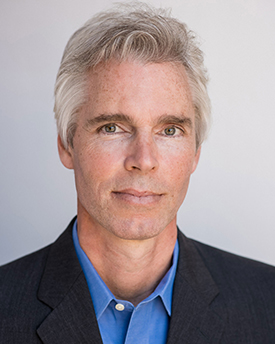
Ted Halstead is the founder, President and CEO of the Climate Leadership Council. (Photo: Climate Leadership Council)
CURWOOD: Ted, before you go, tell me, why does your plan include a proposal to give companies immunity from lawsuits for polluting the atmosphere with greenhouse gases?
HALSTEAD: What we're trying to find here is a package of policies that both sides can live with. So, you need to offer the Republican Party deregulation, and also there is no upside in fighting it out with historic polluters if you have a new plan that dramatically and consistently reduces emissions over time. That is the goal. Let's keep our eyes focused on the goal. It is to solve the climate problem at the required scale and speed. If we have a solution that does that, well then, why not let the companies not have any more legal liability on carbon emissions? By the way, we're not talking about the other greenhouse gases because our policy right now doesn't touch those. But on carbon emissions, if we’re going to price it, well then we shouldn't be litigating it at the same time. It's just sensible politics, right, because the policy works, and if you believe the policy works then you don't need these other sticks at the same time. So, it's all part of finding a compromise that all sides can live with.
CURWOOD: Ted Halstead is Founder, President and CEO of the Climate Leadership Council in Washington. Ted, thanks for taking the time with us today.
HALSTEAD: Thank you, Steve. Much appreciated.
Related links:
- “The Conservative Case for Carbon Dividends”
- NYTimes Op-ed by Martin S. Feldstein, Ted Halstead, and N. Gregory Mankiw,
- Listen to our interview with Republican Congressman Bob Inglis about leading the GOP on climate change
-
[MUSIC: Roswell Rudd & Heather Masse, “Social Call” on August Love, Qusim Basheer/Jon Hendricks, Red House Records]
CURWOOD: Coming up...sex change and other secrets of the oceans. Stay tuned to Living on Earth.
ANNOUNCER: Support for Living on Earth comes from the Gordon and Betty Moore Foundation, and from a friend of Sailors for the Sea, working with boaters to restore ocean health.
[CUTAWAY MUSIC: Elaine LaZizza Cronin, “The Water Is Wide,” Folk Salad, Traditional American, Off the Record Recordings]
Beyond The Headlines
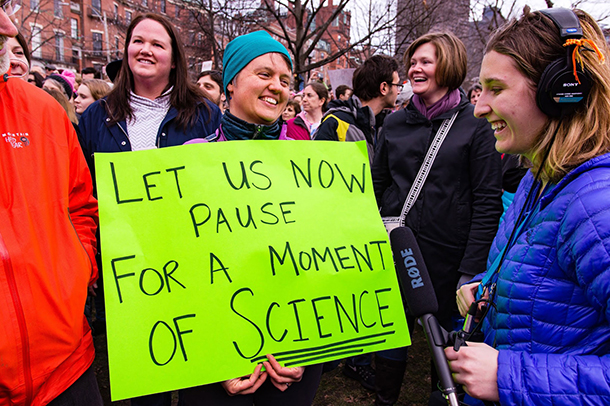
Scientists are planning a “March for Science” in Washington on Earth Day. Above, many marchers held signs about the importance of science at the Boston Women’s March on January 21st, 2017. (Photo: Jarred Barber)
CURWOOD: It’s Living on Earth. I’m Steve Curwood. Time now to consider the world beyond the headlines. Peter Dykstra of DailyClimate.org and Environmental Health News, that’s EHN.org, is on the line from Conyers, Georgia.
Hi, Peter, what do you have for us today?
DYKSTRA: Hi, Steve. I’ve got some sunny news from the other side of the world. China more than doubled its photovoltaic solar energy capacity in the calendar year 2016, and in doing so became the world’s biggest solar-producing nation. China’s National Energy Administration also projected that solar would more than double again by 2020.
CURWOOD: Well, that makes for an interesting dynamic - big growth in China. But how can the U.S. compete?
DYKSTRA: The US probably can compete if it wants to. Solar in China still has a long way to go, and the U.S. is also setting records for solar expansion, but right now, China has about twice as much solar energy capacity. China gets about 20 percent of its energy from renewables, including wind, but a lot of that 20 percent has its own huge environmental baggage, like the Three Gorges hydro dam.
CURWOOD: Yeah, but still, wind and solar look like growth industries and job creators just about everywhere.
DYKSTRA: Yeah, after literally decades of hope and promise, they’re just about here. And so, at least in this country, is an increase in high-level hostility toward climate and environmental science.
CURWOOD: Yeah, a lot of folks are worried about that.
DYKSTRA: With reports of science, environmental, and climate data disappearing from government websites and a general, unmistakable tone from the new administration that any scientist that conflicts with business interests is under the microscope, if not under the gun, many in the science community seem to be undergoing a political awakening.

Solar panels on a hospital in Zhongshan in Guangdong Province, China (Photo: Robert, Flickr CC BY-NC-ND 2.0)
CURWOOD: And that’s pretty unusual, Peter, because the conventional wisdom among most scientists has always been that politics is something to avoid.
DYKSTRA: Maybe not now, if the perception is that politics is about to throw the life’s work of many scientists under the bus. Scientist-organizers – Now there's a concept – are planning a “March for Science” in Washington on Earth Day, April 22.
CURWOOD: Yeah, I’ve got to wonder though, how prepared scientists are to step into the political arena.
DYKSTRA: That many be a problem. It runs the risk of playing right into a Trump narrative. If the science community is seen as part of a cabal with liberals, or Democrats, or environmentalists for a march on Earth Day, the inevitable 3:00 A.M. Presidential tweet will cast scientists as “Enemies of the State”.
March organizers and countless supporters respond that science is under serious attack, and the worst action to take is no action at all. There’s no more time to be a detached scientist, especially on climate and environment issues.
CURWOOD: Yeah, at this point, how much choice is there for scientists?
DYKSTRA: Not much, and I don’t even think that the press and public are aware of the abuse that scientists – particularly climate scientists – take for merely doing their jobs. So, the science community may be facing a huge learning curve on politics, in addition to facing potentially unprecedented political interference. But if any group can deal with a huge learning curve, it’s probably scientists.
CURWOOD: That’s right. They’re always working with new data.
What do we have in this week’s environmental history file?
DYKSTRA: Well, forty-five years ago this week, CBS television premiered “The Lorax,” an animated version of the book written the previous year by the one and only Dr. Seuss.
CURWOOD: And for those folks who don’t know the story of “The Lorax”, give us a quick summary please.
DYKSTRA: Well, Dr. Seuss worked with some of the producers of the legendary Bugs Bunny/Warner Brothers cartoons to tell the story of a forest full of truffula trees threatened by rampant cartoon industrial growth. The Lorax is a stubborn, little, furry creature who “speaks for the trees” because they have no tongues. The TV special re-ran for years and was embraced as an environmental parable around the world, though it was condemned as indoctrination in some communities dependent on the timber industry.
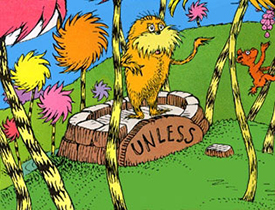
Dr. Seuss’s character the Lorax “speaks for the trees” (Photo: Jennifer Chernoff, Flickr CC BY-ND 2.0)
CURWOOD: Yeah, but The Lorax is still a powerful symbol today.
DYKSTRA: True, but I doubt he’s going to be appointed to run the Forest Service any time soon. In 2012, Hollywood re-made the classic, with Danny DeVito as the voice of the Lorax. Since then, it’s taken in $350 million worldwide in theater, DVD, and online sales and rentals.
CURWOOD: Yeah, so now The Lorax can hire somebody else to speak for the trees on that kind of money.
DYKSTRA: But it might not help. Consider the words of the Once-ler, the bad guy who ultimately gets the Lorax’s conservation lesson:
LORAX: Unless someone like you cares a whole awful lot, nothing’s going to get better. It’s not.
[https://www.youtube.com/watch?v=8V06ZOQuo0k]
CURWOOD: That challenge is still with us some 45 years later.
Thanks, Peter. Peter Dykstra is with Environmental Health News, that’s EHN.org and DailyClimate.org. Talk to you again real soon.
DYKSTRA: OK, Steve, thanks a lot. Talk to you soon.
CURWOOD: And there’s more on these stories at our website, LOE.org.
Related links:
- Reuters: “China’s solar capacity more than doubles in 2016”
- NYTimes: “In Age of Trump, Scientists Show Signs of a Political Pulse”
- Watch The Lorax
- Lorax box office figures
BirdNote: What's in a Name?
.jpg)
Northern Flicker, which used to be known as the Red-shafted Flicker (Photo: Gregg Thompson)
[MUSIC - BIRDNOTE® THEME]
CURWOOD: One of the joys of having a birdfeeder in your yard is seeing and identifying who comes to dine with you. But as Mary McCann observes in today’s BirdNote, nowadays, that can be a bit confusing.
BirdNote®
How Birds’ Names Change
Or Who Took my Rufous-sided Towhee?
[Spotted Towhee trill]
MCCANN: A listener recently wrote us: “Years ago, some of the birds at my feeder were the Rufous-sided Towhee, Oregon Junco, and Red-shafted Flicker [Spotted Towhee trill; Northern Flicker wick-wick-wick call]. But I can’t find them in my current field guides. They're gone, and so are the marsh hawk and sparrow hawk.”
[American Kestrel call]
Well, the listener’s right. Some of these long-familiar bird names have passed into history.
The study of birds, like any science, remains a work in progress. New findings about birds’ DNA or other attributes bring changes in classification of species, which often result in new names. Take the Rufous-sided Towhee, found across North America. Differences between its western and eastern forms – plumage, songs, genetics – brought an official split into two distinct species: the Spotted Towhee in the West [Spotted Towhee trills], the Eastern Towhee in the East [Eastern Towhee “drink-your-tea” song].
The Red-shafted Flicker, on the other hand, was lumped with the Yellow-shafted Flicker, because so many hybrids were found. Now, they all fly from tree to tree as the Northern Flicker.
[Northern Flicker wick-wick-wick call]
But where have the “marsh hawk” and “sparrow hawk” gone? Check your field guide for the Northern Harrier and the American Kestrel.
[American Kestrel call]
I’m Mary McCann.
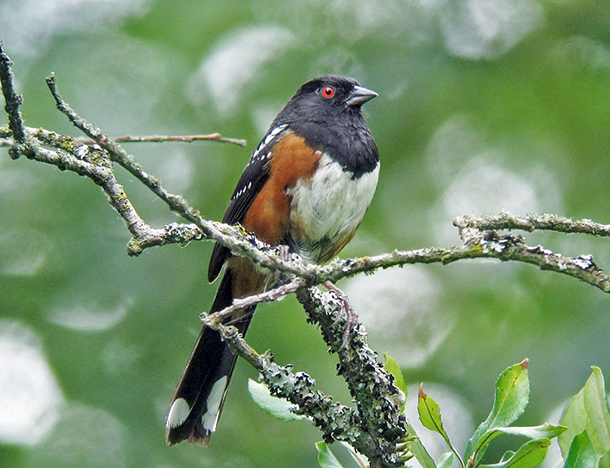
The Rufous-sided Towhee is now known as two distinct species: the Spotted Towhee, shown above, and the Eastern Towhee. (Photo: Mike Hamilton)
###
Written by Bob Sundstrom
Bird audio provided by The Macaulay Library at the Cornell Lab of Ornithology, Ithaca, New York. Spotted Towhee song recorded by K. Colver #49764. Eastern Towhee recorded by W.L. Hershberger #94294. American Kestrel recorded by D.S. Herr #133146. Northern Flicker recorded by R.C. Stein #6819.
BirdNote's theme music was composed and played by Nancy Rumbel and produced by John Kessler.
Ambient sounds recorded by D.S. Herr.
Producer: John Kessler
Executive Producer: Chris Peterson
© 2005-2017 Tune In to Nature.org February 2017 Narrator: Mary McCann
http://birdnote.org/show/how-birds-names-change
CURWOOD: And if you like, you can flit on over to our website, LOE.org, for some pictures.
Related links:
- Listen on the BirdNote website
- Red-shafted and Yellow-shafted Flickers are now called simply Northern Flickers
- The Spotted Towhee, once known as the Rufous-sided Towhee
- The Eastern Towhee was also once known as the Rufous-sided Towhee
[New York Philharmonic/Leonard Bernstein, “Quiet City,” on Copland: Symphony No.3/Quiet City, by Aaron Copland, Deutsche Grammophon]
Sex and Sustainability in the Sea

Sex in the Sea: Our Intimate Connection with Sex-changing Fish, Romantic Lobsters, Kinky Squid and Other Salty Erotica of the Deep is Marah Hardt’s first book. (Photo: courtesy of Marah Hardt)
CURWOOD: The fate of the oceans and fisheries are a topic we often cover here at Living on Earth. Today, we have another take on the subject, from author and coral reef ecologist Marah Hardt, Co-Director of the non-profit Future of Fish, which works to create a global business model for responsible fishing. And for the week leading up to Valentine’s Day, she joined us from a sustainable seafood conference in Malta to discuss her book, and give us her salty take on what happens below the ocean surface. Marah, welcome to Living on Earth.
HARDT: Hi there. Thanks for having me!
CURWOOD: And before we do anything else, please read a passage from your book. It’s page 166.
HARDT: I would love to.
“Her skin shone in the moonlight, a flash of silver against a dark beach. She knew he wanted her. She could see him desperately fighting his way toward her from amongst the crowd. She positioned herself perfectly, knowing the sight of her bound body restrained and prostrate in the sand would make him, would make all of them quiver with excitement. The first to reach her, he feverishly curled himself around her. Others soon joined him, forming their own half-circle embraces. This is what she came here for, what they had all come for.”
CURWOOD: Whew! This sounds kind of hot, Marah, but I guess we need to tell people this not the beginning of your latest romance novel, although it sounds like you have a flair for that sort of thing because you're talking about your new book “Sex in the Sea” where you document various mating rituals and courtship tactics and the sexcapades, they sound foreign but they, in some respects, mirror our own experience as humans. And this passage that you just read us, you're describing, what, this is the shore orgy of the grunion?
HARDT: Of the grunion, yes, so these are small silver fish that could fit in the palm of your hand, and they come ashore every spring to do as you said a mass orgy on the beach. It's their strategy for reproduction and it's a really fun spectacle that folks can go down and watch anywhere along the Southern California shores into Mexico.
CURWOOD: So, as a marine biologist I guess who has this dual career, what compelled you to write this book in this creative writing style you've chosen?
HARDT: So, I was at a cocktail party, I was talking to some friends and we were having one of those conversations where we were lamenting not understanding the opposite sex. So folks were saying, “Gosh, if just for one day I could be in the body of a guy just know how they think or what's going through their head”, and I made very casually this off-hand comment that, "I know if only we could be parrot fish." It was like you could hear a needle drop. I was met with these dropped jaws and open big wide eyes and everybody said, “What are you talking about?” So I said, "Oh, well, you know, parrot fish, they can change sex. They start life as females, and then they transition into males." So, I explained this a little further, how this is a really common strategy for reproduction in the ocean.
People were still listening, they were still really curious, and I said, "Well, you know, if you think about it, that makes things really complicated for management because we tend to like to catch the biggest fish, and if you think about it, if you're catching all the big ones, you're catching all the males. So you might be leaving enough fish in the sea, but if they're all females, your reproduction is going to slow down."
And it was about 20 minutes later I was refilling my wine glass and I heard someone who I had been talking to say to somebody else at the party, "Did you know fish change sex? Isn't that bizarre?" And I thought, “That's it.” If you talk about sex, people are curious, and maybe there's a way that you can talk about sex, draw their attention, and then subtly weave in the message of conservation because ultimately successful sex is the heart of sustainability.
CURWOOD: So talk to me about the various dating games of the deep.
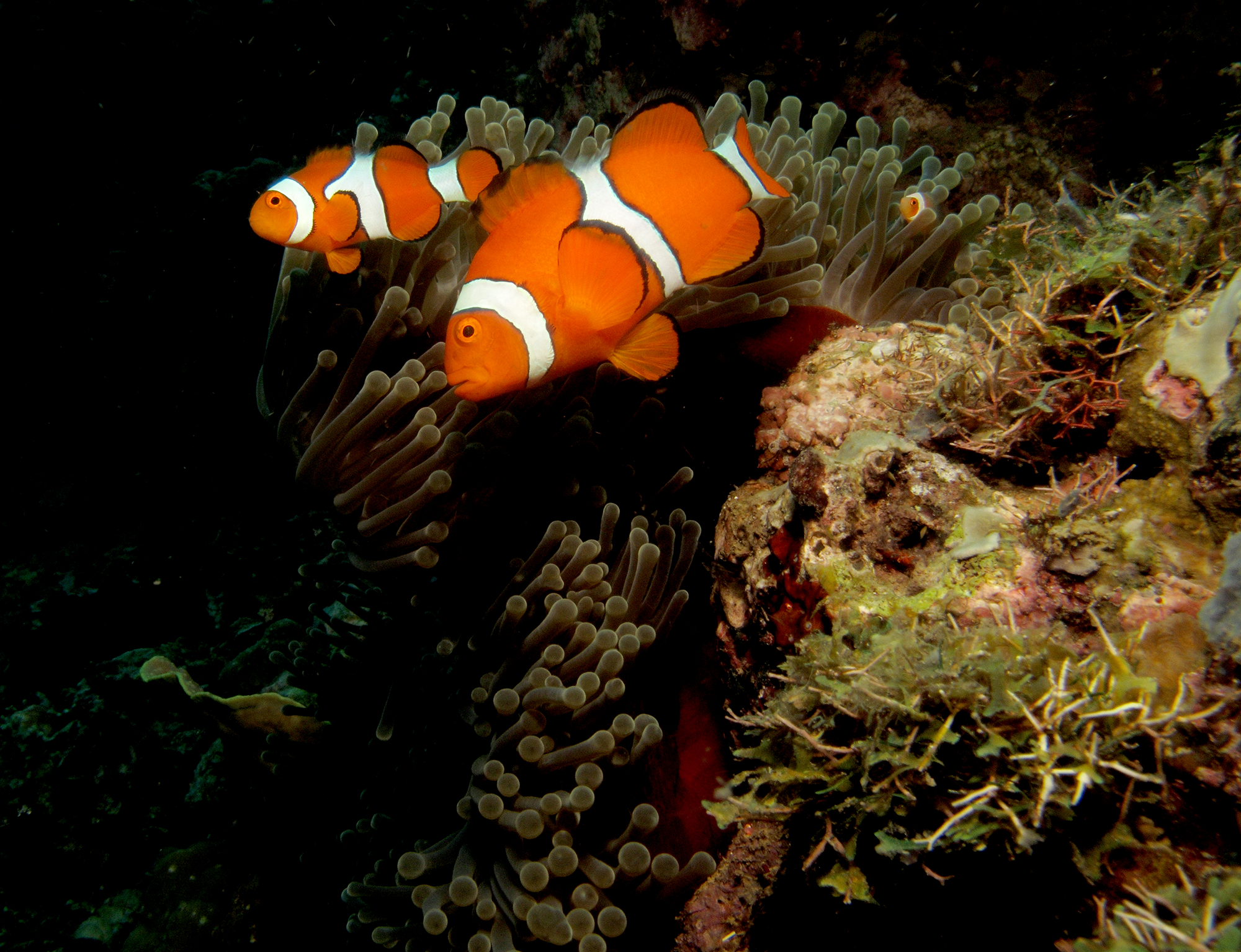
Clownfish, which mostly form in monogamous pairs, can change sex from male to female. (Photo: courtesy of Marah Hardt)
HARDT: So, first, there's the search, which is how species have to find one another which in the ocean is a huge challenge. It's the largest living space on the planet. 99 percent of where animals can live is in the ocean. So, you imagine, it's hard to find one another. So, that's the first challenge, and animals do this in all sorts of different ways, one of which is to do very much like what we do, which is to go to the equivalent of a singles bar or a hotspot for sex.
Nassau Grouper, great example, they will travel down along the reefs. They normally live solitary lives, and so they don't tend to interact with each other very much. But right after the full moon, they will move to the edge of the reef and wait and see when other groupers start passing by, and they gather at the same spot every year, at the same time. They will shift their coloration and change from some desert camo pattern, which is very good for ambush predators to kind of jump out on a reef and get prey, and they switch more into this more sort of “black-tie affair,” where they'll go into a dark black mode or black with a white belly. And these colors sort of signal that they're ready to be friendly, and they're ready to engage more intimately. And then they form these giant, beautiful, swirling balls, and right at dusk, as soon as that light starts to change, you can see they kind of get a little fired up, they get a little antsy.
And very soon after that females are, they look pregnant. They're swollen with eggs, and a female will rocket out from the group, and she'll shoot towards the surface, and the males will follow her and sort of form this funnel moving upwards in the water column. She releases her eggs about 10 to 20 feet below the surface and then males will streak through this cloud of eggs that she's released and they'll release their sperm. These milky clouds form, and the fish sort of tumble back down in this cascading sort of geyser of fish that erupts and then falls to the sea floor, and they'll move up a little bit, up the reef, and do the same thing again. So you get these repeated, it's almost like Old Faithful full of fish that just shoot up, explode.
CURWOOD: [LAUGHS] Fish geysers.
HARDT: Yes, fish geysers, and the visibility will go from 100 feet to where you can't even see in front of your face.
CURWOOD: So this is, uh, if they're Nassau Grouper, they're found off Bermuda?
HARDT: They're found all throughout the Caribbean, but unfortunately these days it's really hard to find them. They follow the same cues every year. In order for the fish to find one another, it also makes it very easy for fishers to find them, and you have all of the biggest fish clumping together all at the same time in a very predictable schedule every year, it's very easy to overfish them. And so we've seen this happen again and again and again, where these spawning aggregations really just get hammered.
CURWOOD: And this phenomenon, of course, allows people who fish to say, “Well, there are plenty of fish,” because they go to these aggregations.
HARDT: It looks, yeah, and the abundances look absolutely huge. You can have the entire breeding population of one island in one location, in one aggregation. So if you wipe that out, they're not coming in from anywhere else and it's really not until you have only a few dozen left that you realize there's no more coming anymore, and that's it.
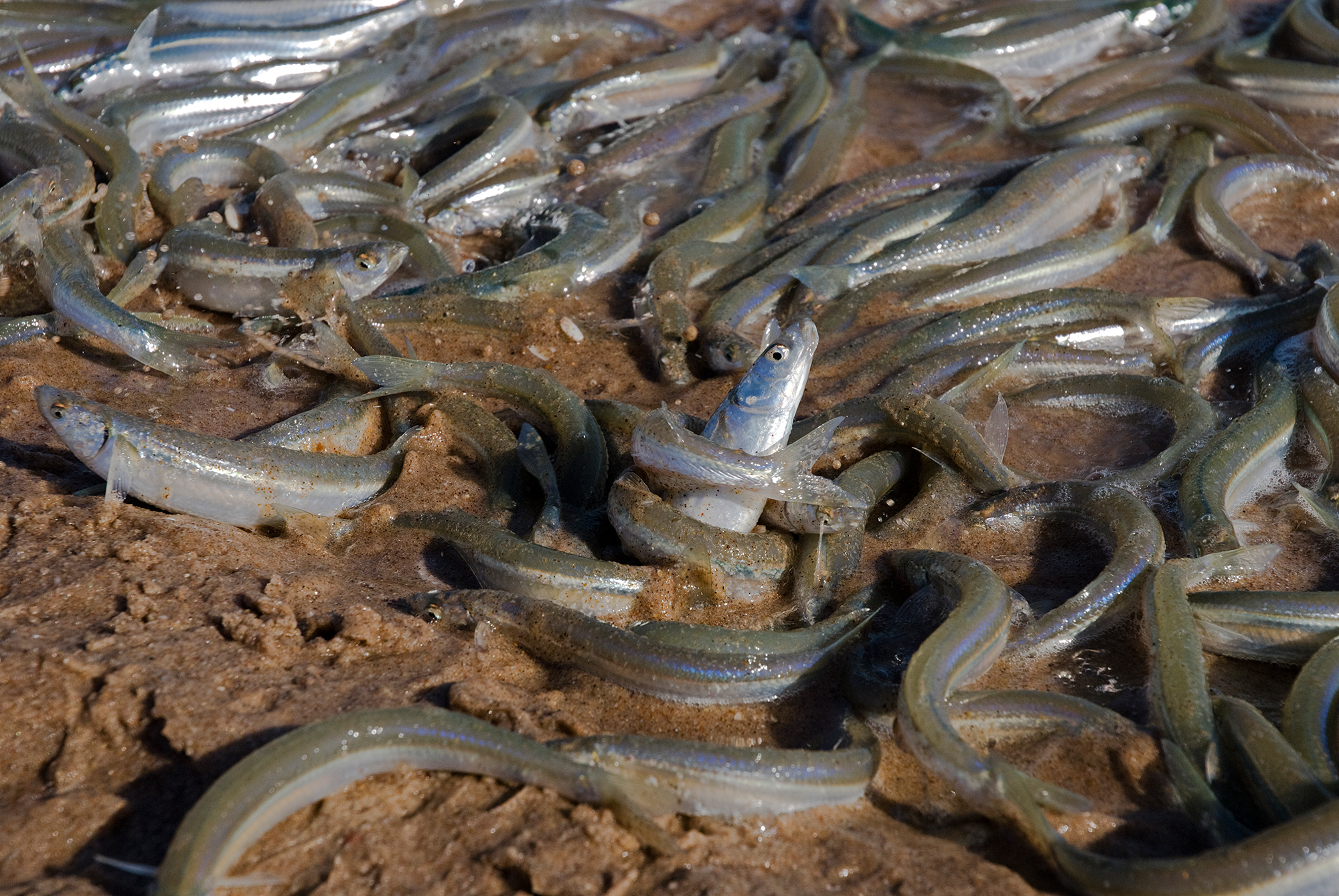
Grunion are small silver fish that come ashore every spring to mate on the beaches of Southern California. (Photo: courtesy of Marah Hardt)
[MUSIC: Louis Armstrong and Oscar Peterson, “Let’s Fall In Love” on Let’s Do It: Best of Verve Years, Cole Porter, Polygram]
CURWOOD: That’s Marah Hardt, author of the book “Sex in the Sea” and we’ll have more of our conversation just ahead. So stay tuned to Living on Earth.
ANNOUNCER: Funding for Living on Earth comes from you our listeners, and United Technologies - combining passion for science with engineering to create solutions designed for sustainability in the aerospace, food refrigeration and building industries. UTC companies such as Otis, Carrier, Pratt & Whitney and UTC Aerospace Systems are helping to move the world forward. This is PRI. Public Radio International.
[CUTAWAY MUSIC: Jo Ann Smith, “Rhythm Of the Rain,” Autoharp Legacy, John Claude Gummoe, Arts In the Wood ]
CURWOOD: It's Living on Earth, I'm Steve Curwood. We continue now with ecologist Marah Hardt, talking about her book “Sex in the Sea”. I asked her about her own specialty, coral reefs.
HARDT: Well, corals are these fantastic animals. They look like little anemones that are trapped in a cup, and they build these little cup houses and those houses then stitch together into apartment buildings that then stitch together into big city blocks and then build reefs so big we can see them from space.
CURWOOD: They're the only creature we can see from space.
HARDT: I think so. Yeah, I believe that's true, the only ones that build living structures large enough to see from space. But because they build these reefs, they're stuck. They can't move to produce. So they reproduce more like what would be almost like a plant system. They release their eggs and sperm into the water column, but the way that they do this is fantastic because you're talking about an animal that has, from our understanding, a pretty basic body plan, no big, higher brain at work here, and yet they organize truly the biggest orgy on the planet, and it's perfectly synchronized. You can set your watch to it, and, in fact, researchers do every year, and it's like all of a sudden, the underwater world turns into a snowstorm, only the snowflakes rise up and are bright pink. So, the corals sit at the bottom of the sea and they release these bundles that are this bright pink coral color. And the bundles are the egg and sperm because most of the big corals that make the big reefs are hermaphrodites. And these bundles float up through the dark water column and then explode at the surface, releasing the egg and sperm and creating this giant slick of coral gametes, the term for eggs and sperm, and it all mixes and mashes at the top, and that's how you get sperm from one individual to mix with an egg of another.
CURWOOD: Except you said that when you observed this, that, well, that there was something really familiar about it.
HARDT: [LAUGHS] There was. So this was one of my more semi-embarrassing moments because it happened very early in my graduate school career. You watch the event, you come up to the surface, and you come up through, again, this slick of coral goo, and it smells very potent and very familiar of other types of sexual activity that you can sense in other animals including our own species. [LAUGHS] So, um, it's a little bit funky, and there is sort of this unspoken initiation among people who study coral sex who sort of always look at each other and think,“Oh my gosh, this is so weird!”
CURWOOD: [LAUGHS] So talk to me about the various dating games of the deep. Now, why in nature is seduction necessary?
HARDT: Well, think about the resources it takes to produce an offspring. So, females in particular have to go through a lot of energy to produce these eggs and, in many cases, to raise the young, or at least care for the young for a little while. So they want to be discerning, they want to ensure that they are making an offspring with a male counterpart who has good genes.
CURWOOD: I have to say that you have a wonderful section about lobster dating, mating, and sex.
HARDT: [LAUGHS] Mmmm, lobsters are so romantic.
CURWOOD: Yeah, I had no idea.
HARDT: I know! I didn't either. What happens with lobsters...it starts off a little kinky and then it gets romantic, so bear with me. I promise we'll get to the romance. Around mating season is very aggressive. The biggest males, they fight, and the largest males gain dominance over the best dens. They go and kind of harass their neighbors, and they literally pee in the front door of their neighbor’s dens, [LAUGHS] and it's quite rude. It's literally just to show that he can.
CURWOOD: This is like the movie "Grease" where these guys from the other group show up in their big car and they say your car is dented and broken and then after they kick it a few times, put in a few more dents, then they roar off.
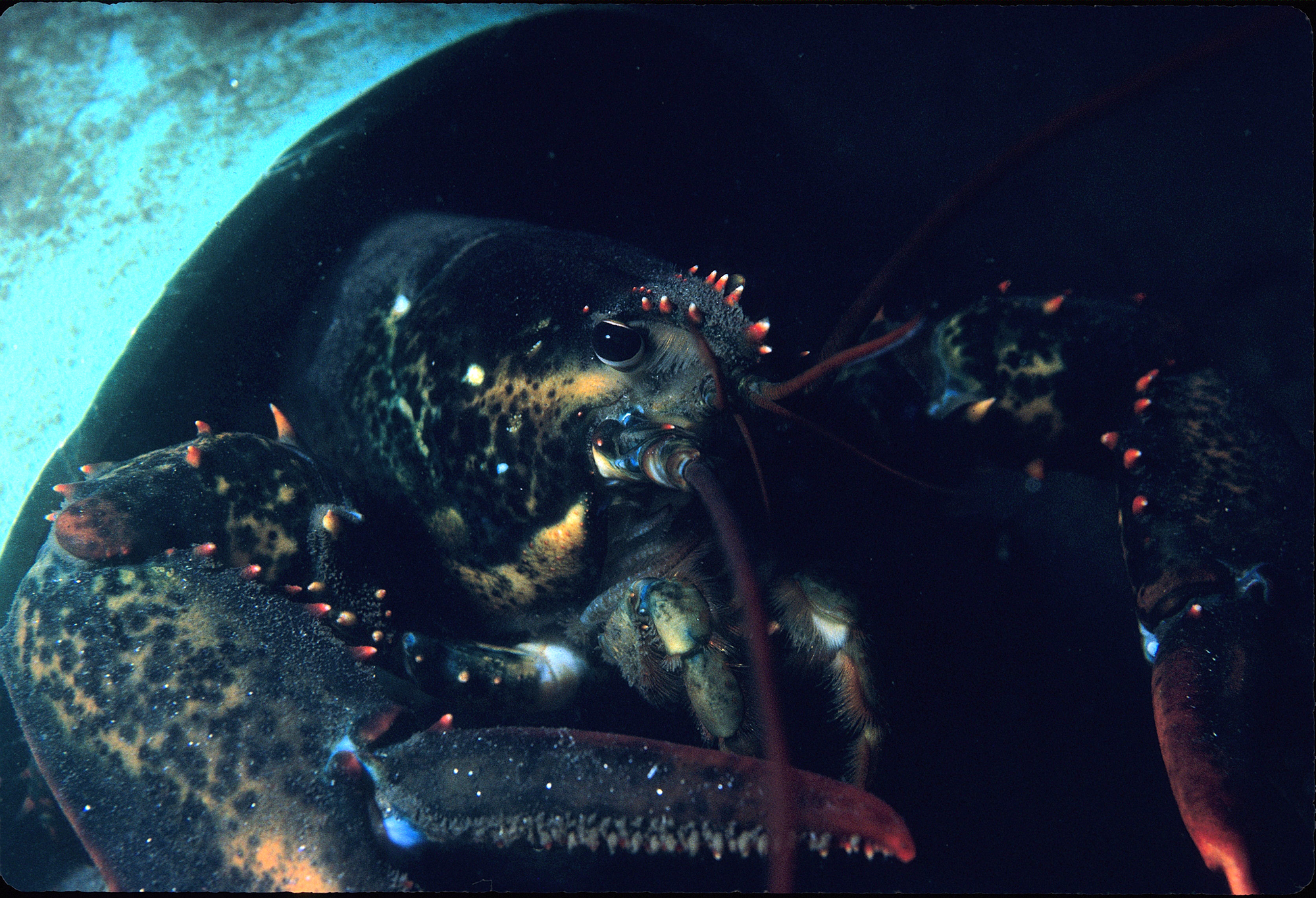
When it is time for her to molt, a female lobster seeks out a strong male, not only to fertilize her eggs, but also to protect her when her body is soft and vulnerable to predators. (Photo: courtesy of Marah Hardt)
HARDT: Exactly. And so this is all fine and good. It helps the females identify who's the biggest, strongest, which, again, for her is a good thing because that's going to be good for her offspring. However, the best time for both females and males to mate is when the female molts because female lobsters have this very neat trick whereby they can lose and regain their virginity. So a female lobster has a pouch underneath her tail where she stores sperm from a male. What this means is right after she molts, she gets a new empty pouch. If she can mate right away, she fills that pouch full and then has more time to fertilize multiple batches before she grows too much and has to molt again. For the male, finding a female who has an empty pouch means he can pour all of his sperm into it and he doesn't have to share that pouch with other male sperm, so that's an advantage for him.
However, for the female, when she molts, she is a soft-bodied animal. She can't even stand for the first half an hour. She is extremely vulnerable to being preyed upon or just killed. So what she does is, she comes up with a love potion to seduce this male, and basically entrance him into becoming very gentle, very caring, very protective lover, and she does this by peeing in his face. So, she creates a stream of urine, and every day will go up to his den, and spray a little bit of urine in, and then she'll run away before he has a chance to be aggressive. She does this for about a week, daily little spritzes in his face, into his den. And after about a week it starts to sort of take hold. He starts to realize, oh, this is a female, this is a ripe female, this female is ready to do something that I think I would like to engage in. When she starts to sense that her potion has taken hold, she will move in with him and for about another week they will cohabitate. They will live together. She will go hunt, he will go hunt, and will kind of hang out. And then this moment comes where she can feel that her molt is about to happen, and she will walk out in front of him and do what Professor Jelle Atema calls “the knighting process”. So the female walks out and turns face-to-face with the male. And I should've explained. Lobsters, their bladders sit below their brains, just behind their eyes so when they spray urine it comes out of these nozzles that are located right on their face under their eyeballs. [LAUGHTER] By coming face-to-face with her mate, she can spray him most effectively and directly. She sprays him with copious amounts of urine. He sprays her back.
CURWOOD: This is an amazing golden shower.
HARDT: It is a 100 percent a golden shower. And he puts his claws down and kind of lowers his head. His big front claws go down into the sand. She lifts yourself up on her walking legs and takes one of her claws and literally taps him once on one shoulder and then across to the other shoulder. It really is like a knighting process, and Dr. Atema says, “You know, it's pretty clear the signal is, ‘Don't go away, I'm about to molt, it's time to get busy’”. And it takes a few hours for the molting process to complete. She kind of slips out of her shell. She, again, can't stand at this point. The male all the while will sort of be near her, sometimes he will run his antennae over hers, sort of stroking her, he will tickle her, like light touches with his walking legs, kind of just checking in on her. And again, from the female's perspective, this whole courtship process has brought her to a point where she now has the biggest toughest male not only to fertilize her eggs, but to protect her in the stage where she is so vulnerable.
CURWOOD: So the oceans are changing, Marah. There's pollution, like a lot more nitrogen. Temperature regimes are changing, climate change. How is this affecting sex underneath the waves?
HARDT: Well in many ways, for example, the lobsters that we were speaking about, they have this very elaborate chemical communication, through their pee, right? And that requires them to be able to smell with very accurate senses, very heightened senses to smelling, and when we put pollutants in the water it can mask those chemical signals, so that they can't necessarily sense what the signal is. And imagine, if you're that female and you're spraying this pee and you think your potion is taking effect and then find out that the male couldn't smell you when you approach him, it's not to be a pretty situation, right?
The other thing is things like ocean acidification, which is another byproduct of climate change in the ocean where we're actually changing the pH of the water, the acidity. All of the little sensors in the antenna, and antennules, they're highly sensitive to chemistry, and they may be damaged or they may be reduced in their capacity in a more acidic ocean. Or it could be that the signals that are being produced, the way that the actual molecules in the urine react with seawater will change based on the acidity. It's as if for centuries lobsters have been writing in English to one another, you know, through their pee, but then all of a sudden with ocean acidification the letters are getting scrambled, and a male is receiving a message that he can no longer understand or read.
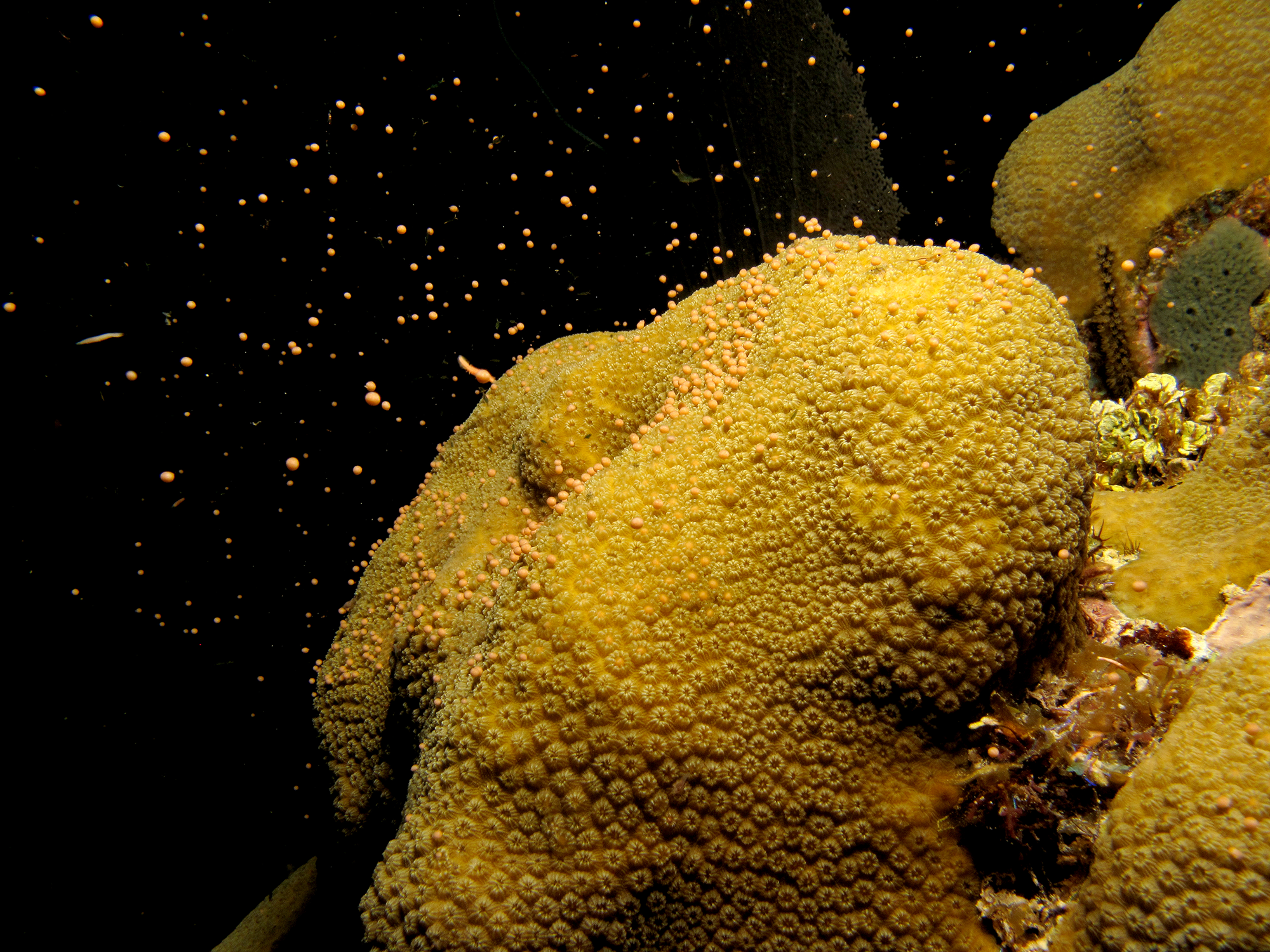
M. annularis coral spawn. Most corals, including M. annularis, are hermaphrodites and release both eggs and sperm that mix on the ocean surface. (Photo: courtesy of Marah Hardt)
CURWOOD: Talk to me about the whales. Now there will probably be a giggle from some listening to us because they know that whales can have humongous organs, but I'm thinking about whales, Right Whales having, well, kind of group sex.
HARDT: Yes, so looking at the anatomy of an animal can tell you a lot about the way that animal reproduces, in particular whether they tend to have many partners or not. Now, in the Right Whale, they're not the biggest whale. They do not have the biggest penis, but they do have the biggest testicles on Earth. Each testes weighs half a ton.
CURWOOD: That's some cojones, I would say.
HARDT: These are some serious cojones, yes. What it tells us is that it is likely that these males are having to compete with other males, internal to the female. So, when we see males with these very large packages, it tends to mean that they are dumping copious amounts of sperm into that female, and the reason to do that is to try to flush out the sperm of other males that may be in there or to push their fellas as far forward as they can. And we knew that lots of group sex was happening. But there's this fantastic - I believe they caught it on video, but there's definitely wonderful photos - where a bunch of research scientists were in their boats.
They were there tagging whales and somebody saw a female come up to the surface and roll onto her back, and a researcher named Dr. Phillip Clapham who is with NOAA, the National Ocean and Atmospheric Administration, tells it that, you know, it wasn't that uncommon, that you would see a female come up and roll and then a male giant pink phallus comes out of the water and will enter into her. But what happened this time was, one male came up on one side, and they all saw. Someone yelled out, “Penis! Insertion is happening!” Everyone,”Okay.” And then somebody went, "Holy smokes there's another one!" And they turn around, and it's like two, giant, bowed penises. I mean, and these things are six feet long. I mean, these are big phalluses coming up, arching out of the water and entering into the female simultaneously.
So we always knew that Right whales were frisky and that there was some sperm competition going on, but, if anything is going to encourage the production of gigantic testes, it's going to be having to ejaculate at the same time as another male is in the female at once.
CURWOOD: It gives new meaning to the phrase, "a whale of a time."

Male right whales have the largest testes of any creature on Earth. (Photo: robdownunder, Flickr CC BY-NC-ND 2.0)
HARDT: Oh my goodness. Yes! [LAUGHS]
CURWOOD: So this brings us to one of the most scientifically provocative parts of your book, and that is probing the scientific mysteries of the vagina. This part of the anatomy which, you know, science, given that guys are guys, tended to pay attention to what you can see rather than what you can't see.
HARDT: This is true and it's wonderful because we're at point now where there is growing recognition of the importance of the female body, anatomy, and behavior in influencing the outcome of reproduction. For a long time, females were thought of as sort of the passive receivers of sperm, and that was really it, especially once sex had happened. So, for internal fertilizers, it was thought that once the male gained access to a female and deposited his sperm, again, there might be some sperm competition going on, but the female really had no control. And a researcher named Dr. Sarah Mesnick who works out of the Southwest Fisheries Science Center in San Diego has been a fantastic mentor in walking me through this marvelous world of whale vaginas in particular.
What they found is rather than thinking of a whale vagina as a single tube leading into, you know, for example, a uterus, it's actually like a maze. They find twists and turns and blind alleys and false flaps and trapdoors, and I remember Sarah saying to me, "When we first looked in this thing, all I could think of was how the heck does a sperm find his way to the cervix? How do they even know where to go?" Again, as Sarah says, “That last mile,” it's female territory.” It's their home turf, so they're controlling a lot more than we realized.
CURWOOD: Talk to me about sex change. You say that fish like the gobi and clown fish can go both ways.
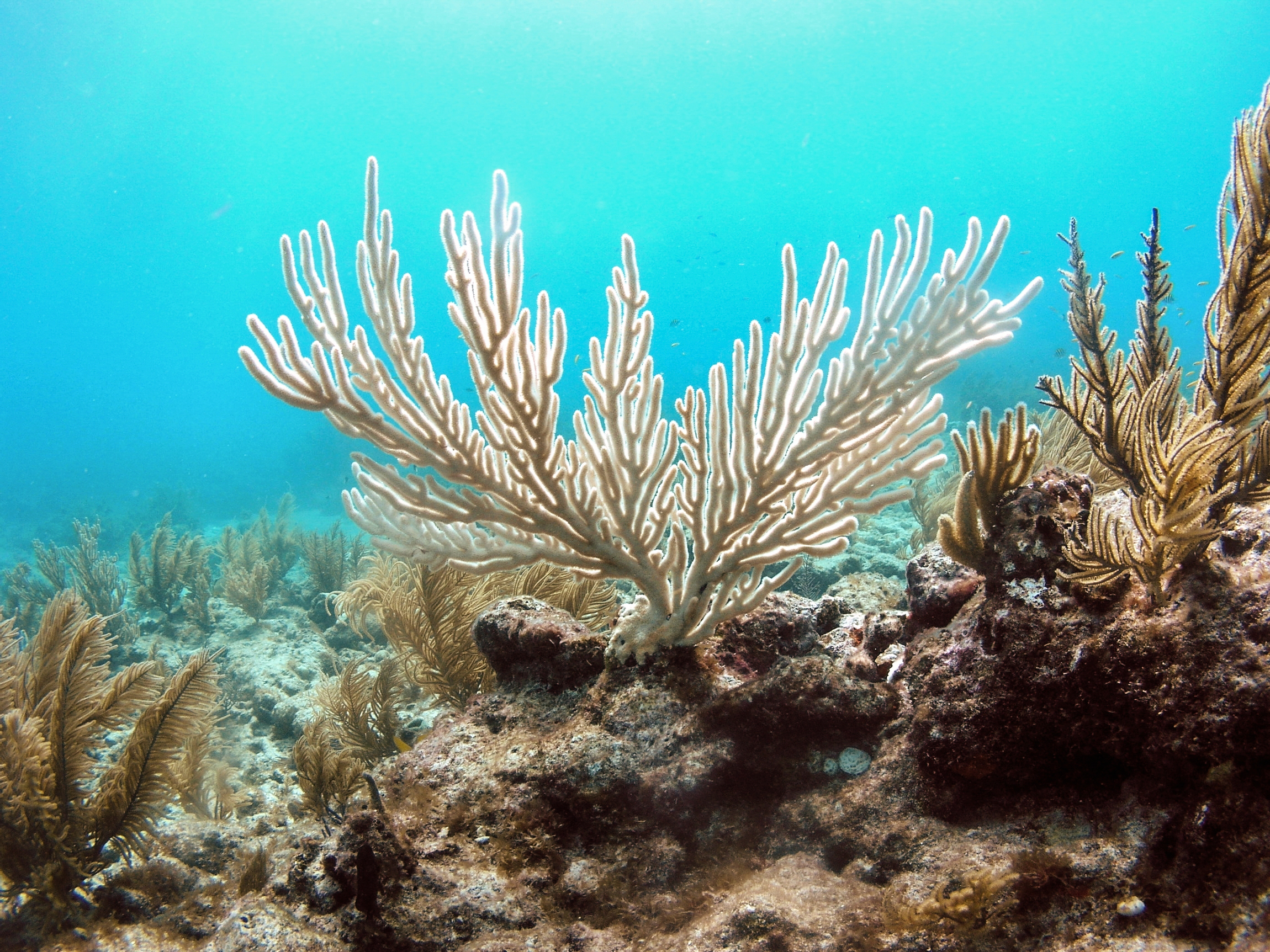
As Earth’s oceans become more polluted and acidic, sea creatures have a harder time sensing their mates and successfully reproducing. (Photo: Kelsey Roberts/U.S. Geological Survey, Flickr CC0 1.0)
HARDT: Yeah, so sex change is a really common strategy in the ocean. Oysters do it. Shrimp do it. Many, many different fish do it. And what it does is, it works really well to help maximize the amount of babies you can make. So, in systems where males can dominate females, but they need to be big to do so, it makes sense when you're small and a little bit less aggressive to be a female. You can reproduce as a female, and then once you've grown big and strong and gained some ability to be a dominant male, you switch into to that male role. And you can take over a harem, and you can defend a territory, and then you can mate with tons of females and keep your reproductive efforts at a max.
In other systems it makes sense to actually go the opposite direction. So, for example, for some species like a clown fish, who get together and stay in relatively monogamous pairs inside their little anemone home - There's a male and a female - It makes sense that you would want to start as a male, hook up with a big female, you're a small male. You can still mate. But then when your bigger female mate passes on, you can take on the big role, grow into being a large female, and take a smaller male along with you. A smaller male has enough sperm to fertilize all the eggs a big female can produce.
What's really crazy when you think about it is, I don't think any of us would choose to go through puberty twice, right?
CURWOOD: [LAUGHS]
HARDT: I mean, let's not do that. But for these fish it's really effective. It's also, again, really important for management because, when you have a sex-changing species, you have to be managing not only the number of fish that are there, you have to make sure you're monitoring the sex ratio. And when we start pulling these fish out, we're triggering them to change sex, perhaps when they might not otherwise, and this can have huge consequences for the amount of reproduction and the success of reproduction.
CURWOOD: Marah, before you go, if you were to come back as a sea creature, based on your studies of underwater erotica, which creature would you choose to be?
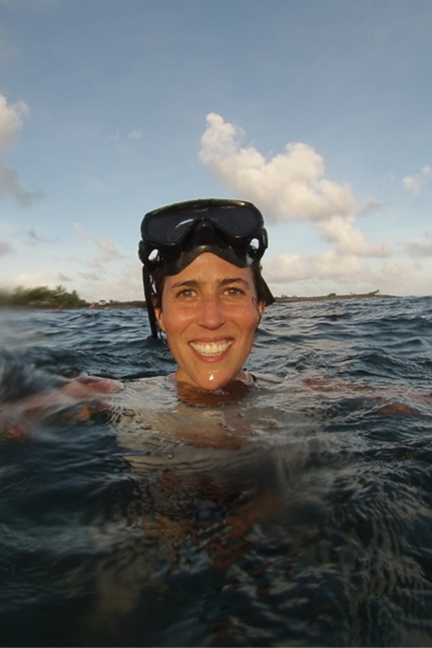
Marah Hardt is a marine biologist, author and research scientist working towards solutions for ocean conservation. (Photo: Joe Laughlin)
HARDT: [LAUGHS] Man, that is such a loaded question. Oh, who would I be? I think that the corals really create a magical spectacle. Coral sex is almost like being a musician who gets to play in this incredible orchestra, and all year long you're practicing your part, right? You're the violinist, or the cellist, and you're practicing your part and just making sure that you have every note perfect, and everything is ready to go. And then you have this one grand night, you know, under the full moon in the tropics, and you all come together, and you play the piece, and it crescendos, pooof! Everything takes off at once. To me that that would be a pretty cool, yeah, a very cool way to reproduce and send off the next generation in this beautiful ethereal group activity that requires a lot of coordination, but you don't have to get too dirty, too messy, not too violent.
CURWOOD: So once a year with passion! [LAUGHS]
HARDT: Once a year with passion, and then everyone leaves you alone. You can go back to doing what you want to do.
CURWOOD: Marah Hardt's new book is called Sex in the Sea: Our Intimate Connection with Sex-changing Fish, Romantic Lobsters, Kinky Squid and Other Salty Erotica of the Deep. Thank you so much, Dr. Hardt, for taking the time with us today.
HARDT: Oh, thank you so much for having me. This was a pleasure.
Related links:
- Marah Hardt’s book Sex in the Sea
- About Marah Hardt
- Sex at Nearly 10,000 Feet Below Ocean's Surface
- 6 Freaky Sex Tips From Sea Creatures
[MUSIC: Sultans Of String with Anwar Khurshid, “Enter the Gate” on Subcontinental Drift By McKhool/Laliberte/Khurshed (SOCAN), MCK Records]
CURWOOD: Living on Earth is produced by the World Media Foundation. Our crew includes Naomi Arenberg, Bobby Bascomb, Savannah Christiansen, Jenni Doering, Noble Ingram, Jaime Kaiser, Don Lyman, Alex Metzger, Helen Palmer, Adelaide Chen, and Jolanda Omari. And we welcome a new intern, Kit Norton, glad to have you with us! Tom Tiger engineered our show, with help from Jake Rego. Alison Lirish Dean composed our themes. You can find us anytime at LOE.org and like us on our Facebook page - PRI’s Living on Earth. And we tweet from @LivingOnEarth. I'm Steve Curwood. Thanks for listening.
ANNOUNCER1: Funding for Living on Earth comes you, our listeners, and from the University of Massachusetts, Boston, in association with its School for the Environment, developing the next generation of environmental leaders. And from the Grantham Foundation for the protection of the environment, supporting strategic communications and collaboration in solving the world’s most pressing environmental problems. Support also comes from the Energy Foundation, serving the public interest by helping to build a strong, clean, energy economy, from Gilman Ordway, and from SolarCity, America’s solar power provider. SolarCity is dedicated to revolutionizing the way energy is delivered by giving customers a renewable alternative to fossil fuels. Information at 888-997-1703. That’s 888-997-1703.
ANNOUNCER2: PRI. Public Radio International.
Living on Earth wants to hear from you!
Living on Earth
62 Calef Highway, Suite 212
Lee, NH 03861
Telephone: 617-287-4121
E-mail: comments@loe.org
Newsletter [Click here]
Donate to Living on Earth!
Living on Earth is an independent media program and relies entirely on contributions from listeners and institutions supporting public service. Please donate now to preserve an independent environmental voice.
NewsletterLiving on Earth offers a weekly delivery of the show's rundown to your mailbox. Sign up for our newsletter today!
 Sailors For The Sea: Be the change you want to sea.
Sailors For The Sea: Be the change you want to sea.
 The Grantham Foundation for the Protection of the Environment: Committed to protecting and improving the health of the global environment.
The Grantham Foundation for the Protection of the Environment: Committed to protecting and improving the health of the global environment.
 Contribute to Living on Earth and receive, as our gift to you, an archival print of one of Mark Seth Lender's extraordinary wildlife photographs. Follow the link to see Mark's current collection of photographs.
Contribute to Living on Earth and receive, as our gift to you, an archival print of one of Mark Seth Lender's extraordinary wildlife photographs. Follow the link to see Mark's current collection of photographs.
 Buy a signed copy of Mark Seth Lender's book Smeagull the Seagull & support Living on Earth
Buy a signed copy of Mark Seth Lender's book Smeagull the Seagull & support Living on Earth

